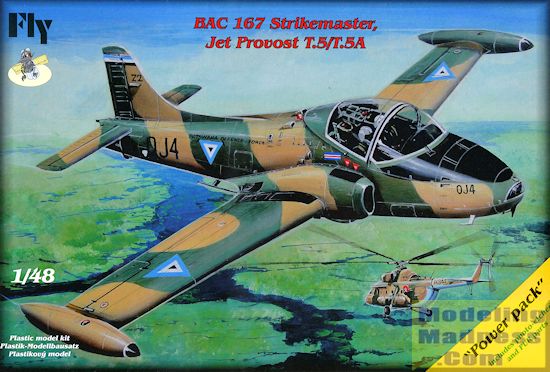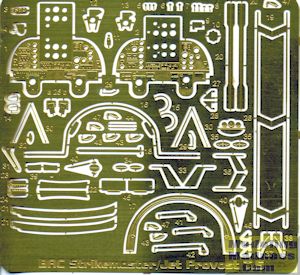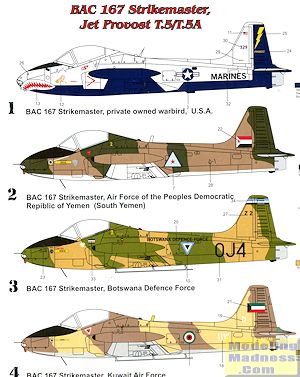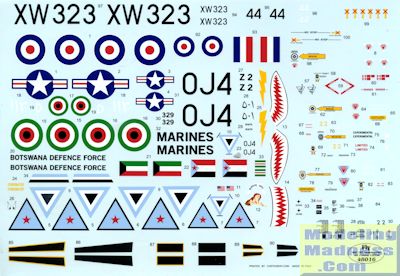
Fly 1/48 Jet Provost T.5/Strikemaster
| KIT #: | 48016 |
| PRICE: | $37.00 with postage direct |
| DECALS: | Five options |
| REVIEWER: | Scott Van Aken |
| NOTES: | Short run with resin and photo etch parts |

| HISTORY |
In the 1950s the RAF issued a requirement for a new dedicated jet training aircraft. Hunting Percival developed the Jet Provost from the piston-engined Percival Provost basic trainer. On 16 June 1954, the prototype XD674 made its first flight from the factory at Luton Airport, flown by Dick Wheldon. The Air Ministry ordered ten of the Jet Provost T1.
In June 1957, an order was placed for the first 40 of the developed Jet Provost T3, featuring a more powerful Armstrong Siddeley Viper jet engine, ejector seats, a redesign of the airframe, and a shortened and strengthened version of the retractable tricycle undercarriage. Percival built one example used purely for structural tests throughout the development stages, giving the designers valuable research into what could be achieved with the basic design. In total, 201 T3s were delivered between 1958 and 1962.
The T4 followed in 1960, fitted with a new Viper engine and first flown on 15th July, and this was followed by the pressurised T5 in 1967.
The T51 was an armed export version, sold to Ceylon (Sri Lanka), Kuwait and Sudan. It was armed with two 7.7-mm (0.303-inch) machine guns. The T52 was another export version sold to Iraq, South Yemen, Sudan and Venezuela, with the same armament as the T51. The T55 was the final armed export version which was sold to Sudan.
A more heavily armed variant of the airframe was developed as the BAC Strikemaster.
The Strikemaster was capable of operating from rough air strips, with dual ejection seats suitable even for low-altitude escape, and it was therefore widely used by third-world nations. Operations by the type was restricted by most military users after the Royal New Zealand Air Force found fatigue cracking in the wings of its aircraft. Many aircraft retired by the Botswana, New Zealand, Saudi Arabia and Singapore have found their way into museums and private collections.
The Strikemaster was deployed by the Royal Air Force of Oman on several occasions during the Dhofar Rebellion, including a notable appearance providing Close Air Support during the Battle of Mirbat. Three Strikemasters were shot down over the course of the war, including one lost to an SA-7 missile. In popular culture, the Battle of Mirbat was the basis for the plot of the 2011 film Killer Elite (film).
The Ecuadorian Air Force deployed the Strikemaster during the brief 1995 Cenepa War, flying ground sorties against Peruvian positions. An Ecuadorian Strikemaster crashed during a training mission in the Northern Border area, near Colombia, on 25 March 2009. Both pilots ejected; one later died of injuries received during the rescue attempt. In all, ten nations operated the Strikemaster in a military role. Several are still operated by civilians.
| THE KIT |
 This kit by Fly is typical of modern short run offerings. The major airframe parts are injected plastic while the more detailed bits are in resin and photo etch is included to add even finer detailing.
This kit by Fly is typical of modern short run offerings. The major airframe parts are injected plastic while the more detailed bits are in resin and photo etch is included to add even finer detailing.
Molding is on a par with MPM or Sword and may actually be farmed out. Detailing is nice a crisp with proper engraved panel lines and none of the engraved rivet detailing that some like and others do not. All of the major pieces will have ejector towers to remove. One sprue contains the fuselage halves and the bit behind the canopy while another has drop tanks and the final one contains all the other pieces included the upper and lower left and right wing halves and tip tanks. There are separate wing tips for those building the Jet Provost option as that aircraft was more often seen without tip tanks than with them.
Most of the cockpit is resin and that includes the sidewalls, control sticks rudder pendals center console and other bits. There is a plastic instrument panel, though also included are both a Jet Provost and Strikemaster instrument panel in photo etch with an acetate sheet that goes behind it for instruments. Most will chose the p.e. option. Now is a good time to mention that the installation of all the photo etch parts is provided at the end of the instruction booklet and the builder will have to alter their construction along the way to incorporate these bits.
Weight is required to prevent tail sitting and there is room for it, though no indication of how much is listed. There are separate intakes that have little depth beyond an inch or so. The tail pipe has a bulkhead to prevent looking into the fuselage. Wheel wells are resin and added to the upper and lower wing halves before gluing them together.
Landing gear legs are plastic as are the retraction struts, with the wheels and oleo scissors in resin. Also resin are the flap hinges and the areas for the guns under the intakes. There are two pylons under each wing and the builder will need to remember to open these if doing the Strikemaster option. Tailplanes are a single casting on each side and slot into the tail. Aileron and elevator hinges are provided in resin. There are separate nose strakes that can be installed depending on the aircraft you are building. The instructions show a two piece windscreen/canopy and also included is a one-piece canopy. The two bang seats are in resin and very nicely molded with harness.
Tailplanes are a single casting on each side and slot into the tail. Aileron and elevator hinges are provided in resin. There are separate nose strakes that can be installed depending on the aircraft you are building. The instructions show a two piece windscreen/canopy and also included is a one-piece canopy. The two bang seats are in resin and very nicely molded with harness.
As mentioned, there is an extensive photo etch fret. The instructions show what is required for the Jet Provost and what is needed for the Strikemaster. One could get away without using the p.e. as this is the part that makes this a 'Power Pack' kit. Quite a few of the p.e. parts replace resin bits such as the aileron and elevator actuators.
 Kit instructions are well done though quite busy. Included are four diagrams for the stencils depending on which version you are building, which is nice as not all stencils are the same on all planes. There are
Kit instructions are well done though quite busy. Included are four diagrams for the stencils depending on which version you are building, which is nice as not all stencils are the same on all planes. There are five markings, four of which are shown here. One which is not shown is for the standard Jet Provost trainer with the RAF. This is in white and red with a violet fuselage band. The other four are a US warbird painted up to look like a T-37 as operated by the Marines (which never flew the T-37, but warbird owners just have a lot of money and not often any historical sense). The other three are in very similar camouflage patters but with different colors. One is for what was South Yemen, another for Botswana and a third with Kuwait. All of the color and markings guides are on the back of the box or on the side panels. The decal sheet is printed by Cartograf so will be superb.
five markings, four of which are shown here. One which is not shown is for the standard Jet Provost trainer with the RAF. This is in white and red with a violet fuselage band. The other four are a US warbird painted up to look like a T-37 as operated by the Marines (which never flew the T-37, but warbird owners just have a lot of money and not often any historical sense). The other three are in very similar camouflage patters but with different colors. One is for what was South Yemen, another for Botswana and a third with Kuwait. All of the color and markings guides are on the back of the box or on the side panels. The decal sheet is printed by Cartograf so will be superb.
| CONCLUSIONS |
This is one of several Jet Provost/Strikemaster boxings by Fly and I for one am pleased that they have produced this aircraft. It is pretty standard short run so those with experience doing these sorts of kits will have no issues. Those who have never built one will find this kit to be a good introduction to the genre.
| REFERENCES |
http://en.wikipedia.org/wiki/BAC_Jet_Provost
http://en.wikipedia.org/wiki/BAC_Strikemaster January 2015 Thanks to me for purchasing this one. If you would like your product reviewed fairly and fairly quickly, please contact the editor or see other details in the